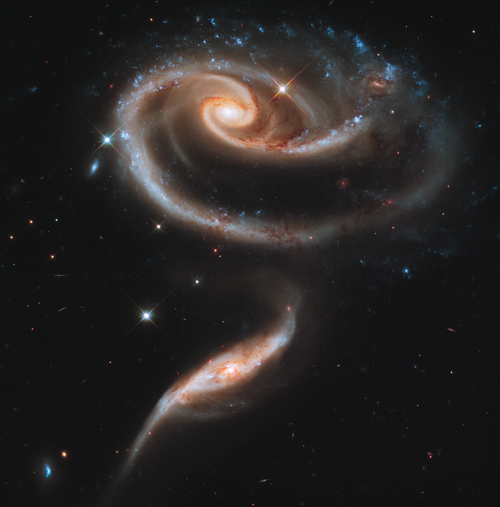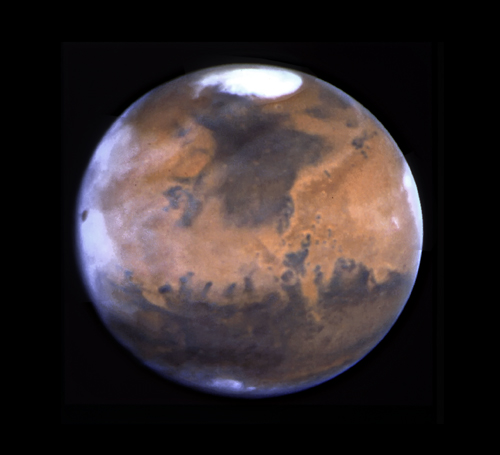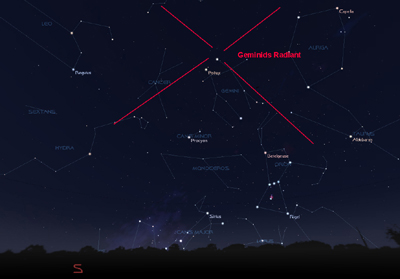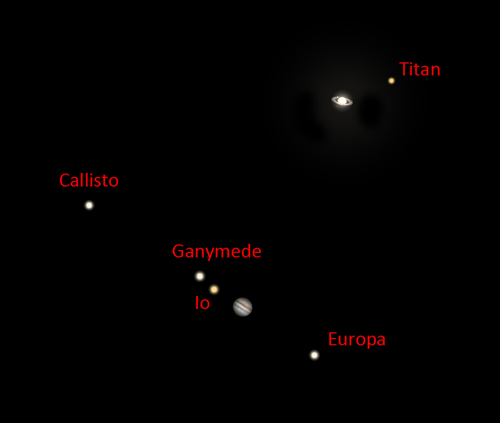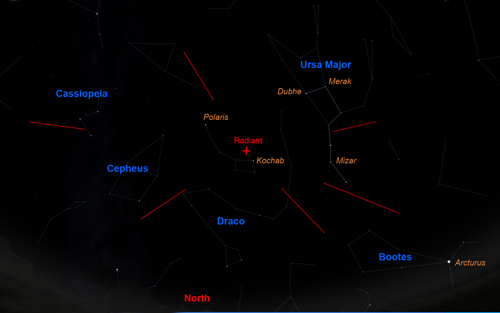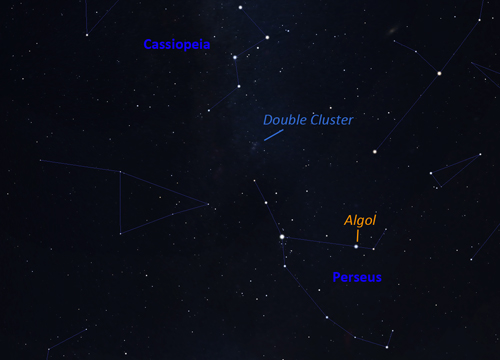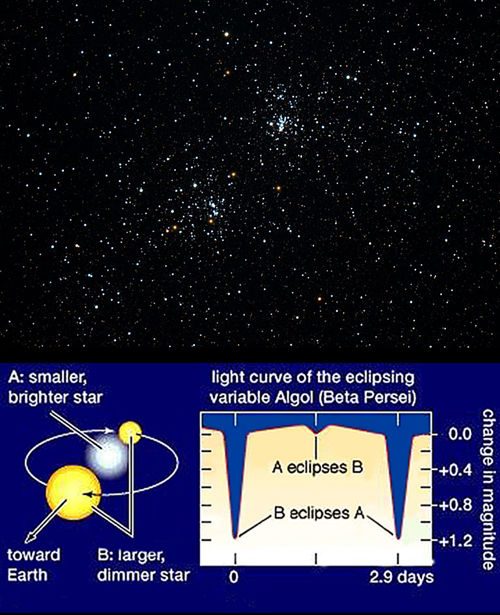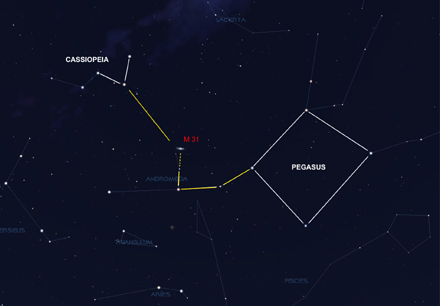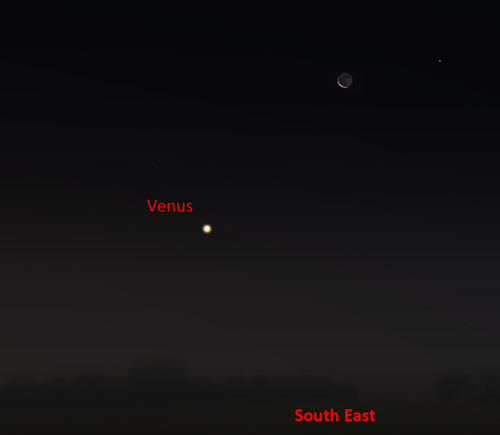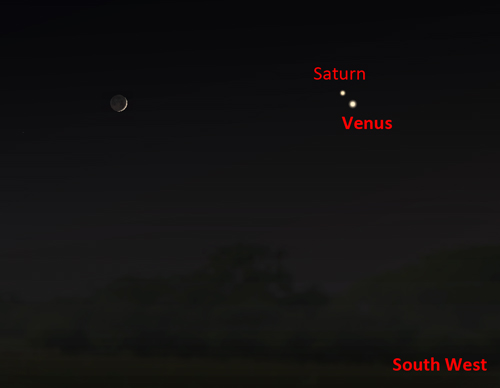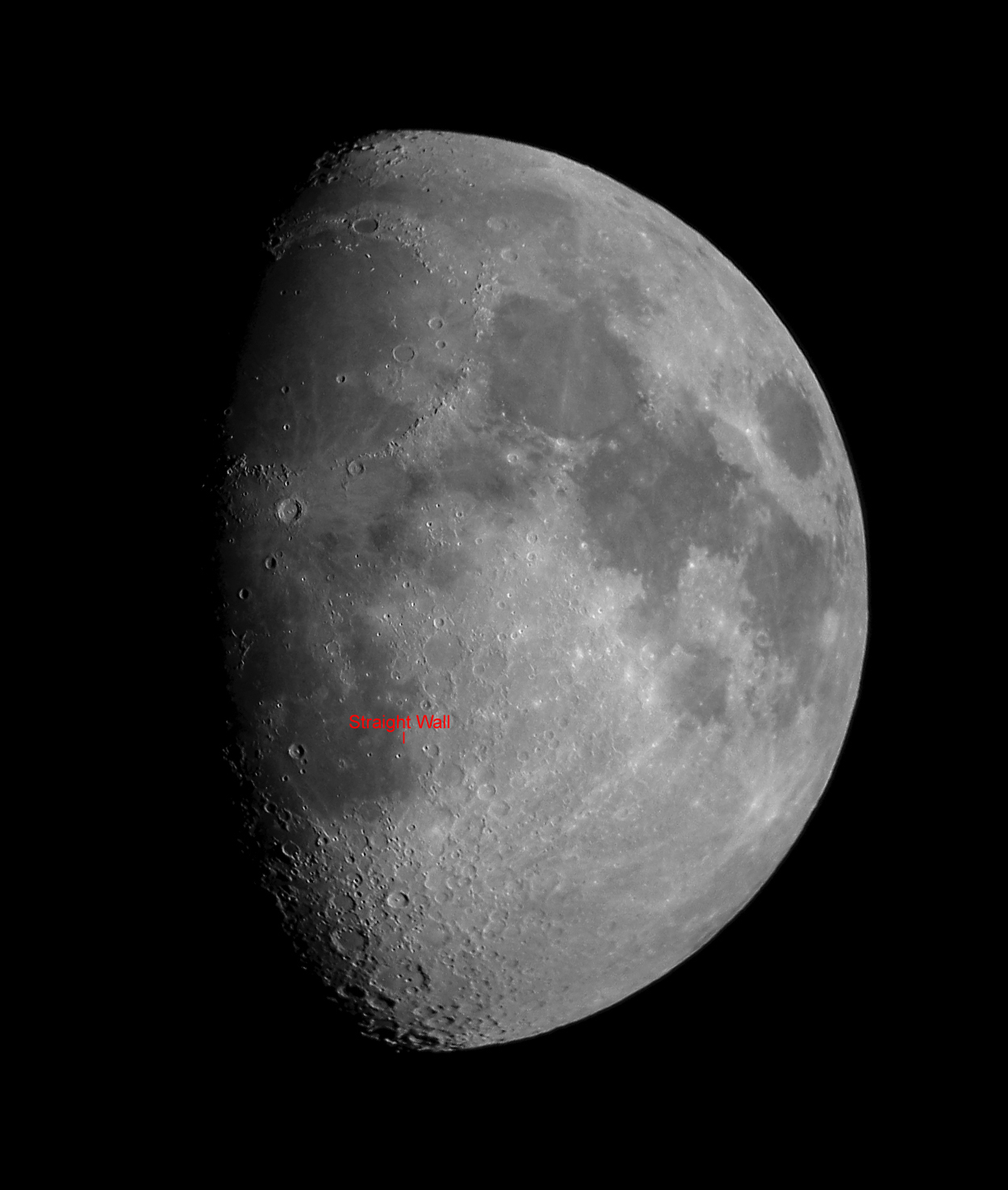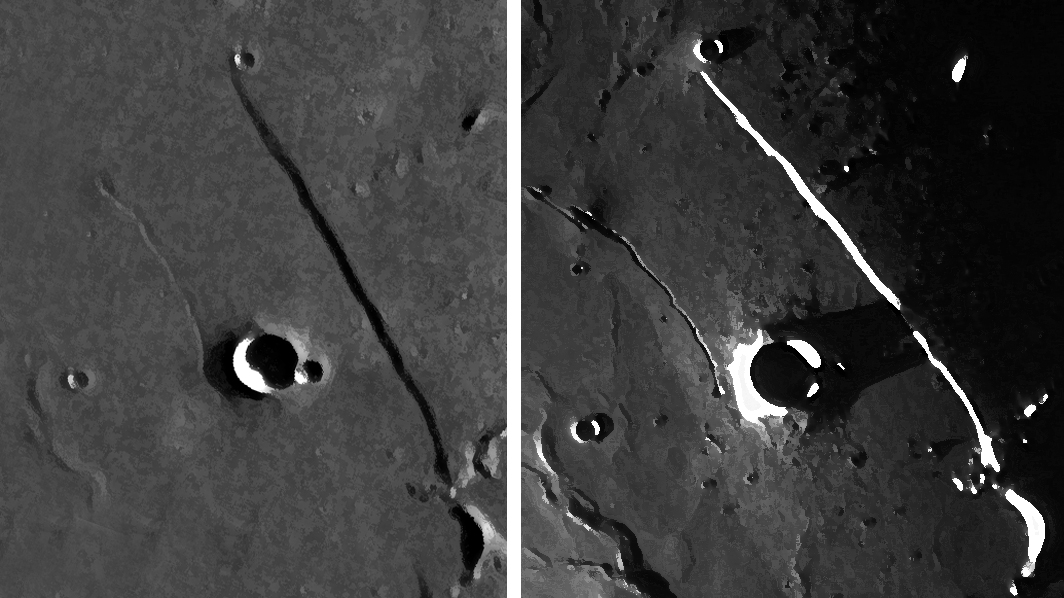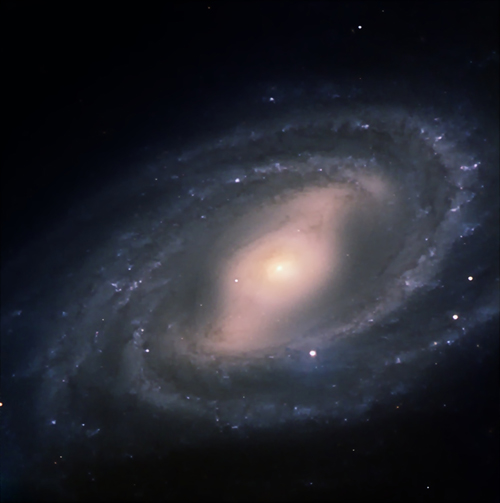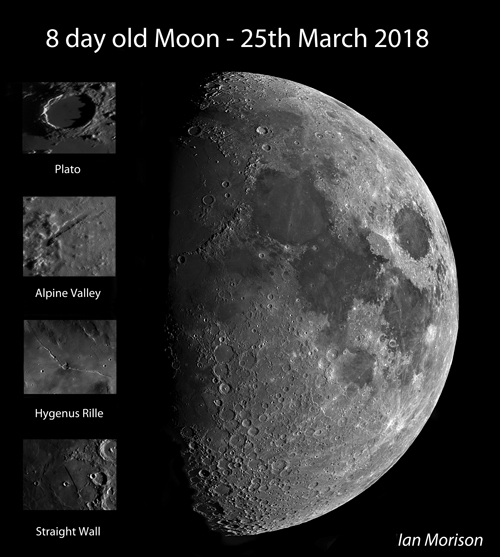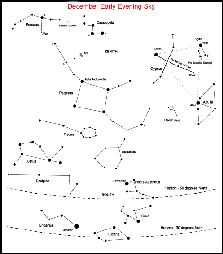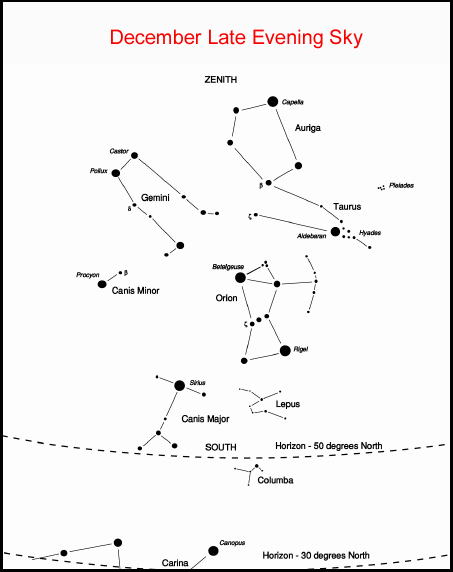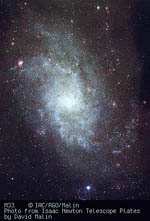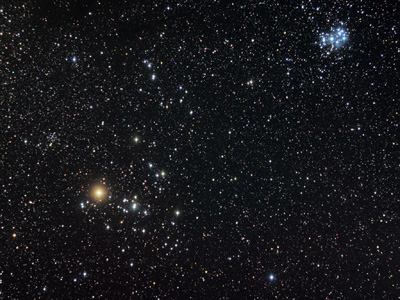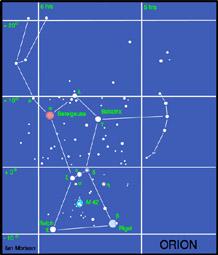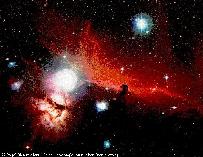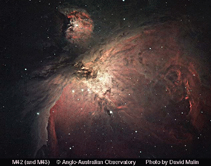The Night Sky December2020
Compiled by Ian Morison
This page, updated monthly, will let you know some of the things that you can look out for in the night sky. It lists the phases of the Moon, where you will see the naked-eye planets and describes some of the prominent constellations in the night sky during the month.
New(ish)
The author's: Astronomy Digest
which, over time, will provide useful and, I hope, interesting articles for all amateur astronomers. A further aim is to update and add new material to link with the books recently published by Cambridge University Press and which are described on the home page of the digest. It now includes nearly 100 illustrated articles.Image of the Month
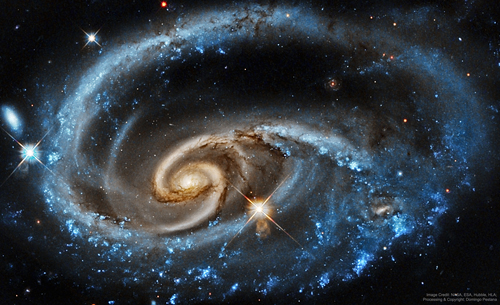
Galaxy in turmoil - UGC 1810
This is an HST image of the galaxy UGC 1810 which lies some 300 million light years away in the constellation Andromeda. Its outer spiral arms contain dark dust clouds, star forming regions and young, massive, blue stars. The burst of star formation giving rise to these stars over the past few million years is the result of the tidal interactions with its smaller neighbouring galaxy, UGC 1813, both seen together in the image below with the pair named ARP 173. In contrast, the spiral arms in the inner part of UGC 1810 contain older, redder, stars entwined with filamentary dust. In, perhaps, 1 billion years it is likely that UGC1810 will devour its smaller neighbour and settle down as a classic spiral galaxy. [There are three foreground stars showing diffraction spikes caused by the Hubble Telescope's secondary mirror support struts.]
Highlights of the Month
Early December - still a good time to view Mars.
This is still a good month to observe Mars which had its closest approach to Earth back on October the 6th when it lay 39 million miles from Earth and reached opposition on the 13th. Wonderfully, at this opposition, Mars has been far higher in the sky than at recent oppositions. In Pisces, Mars, shining at a magnitude of -1.1 at the start of the month, can be seen crossing the meridian at 20:30 GMT. By month's end it magnitude will have dropped to -0.3 whilst being due south at ~19:15 GMT. Its angular size is just over 14 arc seconds at the start of the month dropping to 10.5 arc seconds by month's end. Reaching an elevation of ~45 degrees when due south as seen from the UK, amateur telescopes will enable one to see features, such as Syrtis Major, on its surface when the seeing conditions are good.
During this apparition, Mar's southern hemisphere is tipped towards the Earth and so the South Polar Cap should be visible, though much of its frozen carbon dioxide will have vaporised during the Martian summer. Though the North Polar Cap is beyond our view, one should be able to spot the haze of the North Polar Hood lying above the northern limb of the planet. At 24.6 hours long, the Martian day is similar to ours, so the surface details remain similar at the same time each night. Mars takes 41 days to make an apparent rotation as seen from Earth.
December 14th and 15th after midnight: the Geminid Meteor Shower.
The Geminids
The early mornings of December 14th and 15th will give us the chance, if clear, of observing the peak of the Geminid meteor shower. The Moon is new so, pleasingly, its light will not hinder our view. The Geminids can often produce near-fireballs and so the shower is well worth observing if it is clear. An observing location well away from towns or cities will pay dividends. The relatively slow moving meteors arise from debris released from the asteroid 3200 Phaethon. This is unusual, as most meteor showers come from comets. The radiant - where the meteors appear to come from - is close to the bright star Castor in the constellation Gemini as shown on the chart. If it is clear it will be cold - so wrap up well, wear a woolly hat and have some hot drinks with you.
December 21st - after sunset - The closest visible conjunction of Jupiter and Saturn since 1226!
After sunset on the 21st of December, let us hope for clear skies as Saturn and Jupiter will be at their closest in the sky since the middle ages at just 6 arc minutes apart! This means that with a telescope at moderate power one would be able to encompass both planets and their brighter satellites; Io Europa, Ganymede and Callisto with Jupiter and Titan with Saturn.
December 22nd/23rd - late evenings: the Ursid Meteor Shower
The late evenings of the 22nd and 23rd of December are when the Ursid meteor shower will be at its best - though the peak rate of ~10-15 meteors per hour is not that great. Pleasingly, this year the first quarter Moon Moon will set around midnight so its light will not greatly hinder our view. The radiant lies close to the star Kochab in Ursa Minor (hence their name), so look northwards at a high elevation. Occasionally, there can be a far higher rate so its worth having a look should it be clear.December - evening: the Double Cluster and the 'Demon Star', Algol.
This month, in the evening, is a good time to look high in the south towards the constellations of Cassiopea and Perseus. Perseus contains two interesting objects; the Double Cluster between the two constellations and Algol the 'Demon Star'. Algol in an eclipsing binary system as seen in the diagram below. Normally the pair has a steady magnitude of 2.2 but every 2.86 days this briefly drops to magnitude 3.4.
December: find M31 - The Andromeda Galaxy - and perhaps M33 in Triangulum
In the late evenings when the Moon is not prominent, the galaxy M31 in Andromeda will be visible high in the south. The chart provides two ways of finding it:
1) Find the square of Pegasus. Start at the top left star of the square - Alpha Andromedae - and move two stars to the left and up a bit. Then turn 90 degrees to the right, move up to one reasonably bright star and continue a similar distance in the same direction. You should easily spot M31 with binoculars and, if there is a dark sky, you can even see it with your unaided eye. The photons that are falling on your retina left Andromeda well over two million years ago!
2) You can also find M31 by following the "arrow" made by the three rightmost bright stars of Cassiopeia down to the lower right as shown on the chart.
Around new Moon (14th December) - and away from towns and cities - you may also be able to spot M33, the third largest galaxy after M31 and our own galaxy in our Local Group of galaxies. It is a face on spiral and its surface brightness is pretty low so a dark, transparent sky will be needed to spot it using binoculars (8x40 or, preferably, 10x50). Follow the two stars back from M31 and continue in the same direction sweeping slowly as you go. It looks like a piece of tissue paper stuck on the sky just a bit brighter than the sky background. Good Hunting!
December 12th - 1 hour before sunrise - Venus and a thin crescent Moon.
Before dawn on the 12th of December, Venus will be seen, if clear, down to the lower left of a very thin crescent Moon. Look out for the 'dark' side of the Moon illuminated with light reflected from the Earth - 'Earthshine'.
December 17th - after sunset - Jupiter, Saturn and a thin crescent Moon
After sunset on the 17th of December, Saturn and Jupiter will be seen, if clear, to the right of a very thin crescent Moon. Look out for the 'dark' side of the Moon illuminated with light reflected from the Earth - 'Earthshine'.
December - Evenings of the 7th and 23th: The Straight Wall
The Straight Wall
The Straight Wall, or Rupes Recta, is best observed either 1 or 2 days after First Quarter or a day or so before Third Quarter. To honest, it is not really a wall but a gentle scarp - as Sir Patrick has said "Neither is it a wall nor is it straight!"
M109 imaged with the Faulkes Telescope
The Galaxy M109, imaged by Daniel Duggan.
This image was taken using the Faulkes Telescope North by Daniel Duggan - for some time a member of the Faulkes telescope team. It shows the barred spiral galaxy M109 that lies at a distance of 83 million light years in the constellation of Ursa Major. It is the brightest galaxy in the Ursa Major group of some 50 galaxies. Our own Milky Way galaxy is now thought to be a barred spiral like M109.
Learn more about the Faulkes Telescopes and how schools can use them: Faulkes Telescope"
Observe the International Space Station

The International Space Station and Jules Verne passing behind the Lovell Telescope on April 1st 2008.
Image by Andrew Greenwood
Use the link below to find when the space station will be visible in the next few days. In general, the space station can be seen either in the hour or so before dawn or the hour or so after sunset - this is because it is dark and yet the Sun is not too far below the horizon so that it can light up the space station. As the orbit only just gets up the the latitude of the UK it will usually be seen to the south, and is only visible for a minute or so at each sighting. Note that as it is in low-earth orbit the sighting details vary quite considerably across the UK. The NASA website linked to below gives details for several cities in the UK. (Across the world too for foreign visitors to this web page.)
Note: I observed the ISS three times recently and was amazed as to how bright it has become.
Find details of sighting possibilities from your location from: Location Index
See where the space station is now: Current Position
The Moon

The Moon at 3rd Quarter. Image, by Ian Morison, taken with a 150mm Maksutov-Newtonian and Canon G7.
Just below the crator Plato seen near the top of the image is the mountain "Mons Piton". It casts a long shadow across the maria from which one can calculate its height - about 6800ft or 2250m.
| new moon | first quarter | full moon | third quarter |
|---|---|---|---|
| December 14th | December 21st | December 30th | December 8th |
Some Lunar Images by Ian Morison, Jodrell Bank Observatory: Lunar Images
A World Record Lunar Image
To mark International Year of Astronomy, a team of British astronomers have made the largest lunar image in history and gained a place in the Guinness Book of Records! The whole image comprises 87.4 megapixels with a Moon diameter of 9,550 pixels. The resolution of ~0.4 arc seconds allows details as small as 1km across to be discerned! The superb quality of the image is shown by the detail below of Plato and the Alpine Valley. Craterlets are seen on the floor of Plato and the rille along the centre of the Alpine valley is clearly visible. The image quality is staggering! The team of Damian Peach, Pete lawrence, Dave Tyler, Bruce Kingsley, Nick Smith, Nick Howes, Trevor Little, David Mason, Mark and Lee Irvine with technical support from Ninian Boyle captured the video sequences from which 288 individual mozaic panes were produced. These were then stitched together to form the lunar image.
Please follow the link to the Lunar World Record website and it would be really great if you could donate to Sir Patrick Moore's chosen charity to either download a full resolution image or purchase a print.
The 8 day old Moon
This image was taken by the author on a night in March 2018 when the Moon was at an elevation of ~52 degrees and the seeing was excellent. This enabled the resolution of the image to be largely determined by the resolution of the 200 mm aperture telescope and the 3.75 micron pixel size of the Point Grey Chameleon 1.3 megapixel video camera. The use of a near infrared filter allowed imaging to take place before it was dark and also reduced the effects of atmospheric turbulence. The 'Drizzle' technique developed by the Hubble Space Telescope Institute (HSTI) was used to reduce the effective size of the camera's pixels to allow the image to be well sampled. Around 100 gigabytes of data, acquired over a 2 hour period, was processed to produce images of 54 overlapping areas of the Moon which were then combined to give the full lunar disk in the free 'stitching' program Microsoft ICE. A further HSTI development called 'deconvolution sharpening' was then applied to the image. The Moon's disk is ~6,900 pixels in height and has a resolution of 0.6 to 0.7 arc seconds. Interestingly, as seen in the inset image, the rille lying along the centre of the Alpine Valley is just discernable and this is only ~0.5 km wide! [Due to size limitations the large image is 2/3 full size.]
The Planets
Jupiter
Jupiter, along with Saturn, still remains visible, low in the sky, west of south when darkness falls as December begins and sets around 19:00 GMT. Towards the end of the month it will be seen towards the southwest after sunset and sets by ~17:30 GMT. Its magnitude remains at -2.0 during the month whilst its angular diameter falls from 34.4 to 32.9 arc seconds. Sadly, even when first seen after sunset, it will only have an elevation of ~12 degrees above the horizon so the atmosphere will limit our view. Due its position in the most southerly part of the ecliptic this has been a very poor apparition for those of us in the northern hemisphere.
Saturn
Saturn closely follows Jupiter into the sky, some 2 degrees behind at the start of the month but reducing to just 6 arc minutes on the evening of the 21st! [See highlight above.] Saturn is best seen in the south just after sunset at the start of the month. Its magnitude remains steady at +0.6 whilst its angular size decreases from 15.7 to 15.3 arc seconds. The rings span some 35 arc seconds across and, at ~22 degrees to the line of sight, show up well. Saturn starts the month in Sagittarius and moves into Capricornus on the 15th. Sadly again, its low elevation of ~12 degrees when first visible in the evening will limit our views of this most beautiful planet.
Mercury
Mercury will be visible using binoculars very low in the southeast at dawn for the first few days of the month. On the first, it rises only 45 minutes before the Sun shining at magnitude -0.8. It will pass through superior conjunction (closest to the Earth) on the 20th of the month. Please do not use binoculars after the Sun has risen.
Mars
Mars: See highlight above.
Venus
Venus, rises in the southeast some 2 hours before the Sun at the start of December but by half an hour less by month's end. Its magnitude remains at -3.9 throughout the month whilst its angular sizereduces from 11.7 to 10.7 arc seconds. At the same time its phase, the percentage illuminated disk, increases from 89% to 94% which explains why its magnitude remains constant.
The Stars
The Early Evening December Sky
The Late Evening December Sky
The maps shows the constellations seen towards the south in the early and late evening. Setting towards the west in early evening is the beautiful region of the Milky Way containing both Cygnus and Lyra. Below is Aquilla. The three bright stars Deneb (in Cygnus), Vega (in Lyra) and Altair (in Aquila) make up the "Summer Triangle". East of Cygnus is the great square of Pegasus - adjacent to Andromeda in which lies M31, the Andromeda Nebula. To the north lies "w" shaped Cassiopeia and Perseus. The map shows the constellation Taurus, with its two lovely clusters, the Hyades and the Pleaides, and is also described in more detail below. As the evening draws on, Orion, the Hunter, follows Taurus into the eastern sky with the constellations Auriga, above, and Gemini, to the upper left. Later Sirius, in Canis Major will be seen to the lower left of Orion. Due to its brightness and scintillations caused by the atmosphere it often appears as a rainbow of colours flashing in the sky.
The constellations Pegasus and Andromeda
Pegasus
The Square of Pegasus is in the south during the evening and forms the body of the winged horse. The square is marked by 4 stars of 2nd and 3rd magnitude, with the top left hand one actually forming part of the constellation Andromeda. The sides of the square are almost 15 degrees across, about the width of a clentched fist, but it contains few stars visibe to the naked eye. If you can see 5 then you know that the sky is both dark and transparent! Three stars drop down to the right of the bottom right hand corner of the square marked by Alpha Pegasi, Markab. A brighter star Epsilon Pegasi is then a little up to the right, at 2nd magnitude the brightest star in this part of the sky. A little further up and to the right is the Globular Cluster M15. It is just too faint to be seen with the naked eye, but binoculars show it clearly as a fuzzy patch of light just to the right of a 6th magnitude star.
Andromeda
The stars of Andromeda arc up and to the left of the top left star of the square, Sirra or Alpha Andromedae. The most dramatic object in this constellation is M31, the Andromeda Nebula. It is a great spiral galaxy, similar to, but somewhat larger than, our galaxy and lies about 2.5 million light years from us. It can be seen with the naked eye as a faint elliptical glow as long as the sky is reasonably clear and dark. Move up and to the left two stars from Sirra, these are Pi amd Mu Andromedae. Then move your view through a rightangle to the right of Mu by about one field of view of a pair of binoculars and you should be able to see it easily. M31 contains about twice as many stars as our own galaxy, the Milky Way, and together they are the two largest members of our own Local Group of about 3 dozen galaxies.
M33 in Triangulum
If, using something like 8 by 40 binoculars, you have seen M31 as described above, it might well be worth searching for M33 in Triangulum. Triangulum is
the small faint constellation just below Andromeda. Start on M31, drop down to Mu Andromedae and keep on going in the same direction by the same distance as you have moved from M31 to Mu Andromedae. Under excellent seeing conditions (ie., very dark and clear skies) you should be able to see what looks like a little piece of tissue paper stuck on the sky or a faint cloud. It appears to have uniform brightness and shows no structure. The shape is irregular in outline - by no means oval in shape and covers an area about twice the size of the Moon. It is said that it is just visible to the unaided eye, so it the most distant object in the Universe that the eye can see. The distance is now thought to be 3.0 Million light years - just greater than that of M31.
The constellation Taurus
Taurus is one of the most beautiful constellations and you can almost imagine the Bull charging down to the left towards Orion. His face is delineated by the "V" shaped cluster of stars called the Hyades, his eye is the red giant star Aldebaran and the tips of his horns are shown by the stars beta and zeta Tauri. Although alpha Tauri, Aldebaran, appears to lie amongst the stars of the Hyades cluster it is, in fact, less than half their distance lying 68 light years away from us. It is around 40 times the diameter of our Sun and 100 times as bright.
More beautiful images by Alson Wong : Astrophotography by Alson Wong
To the upper right of Taurus lies the open cluster, M45, the Pleiades. Often called the Seven Sisters, it is one of the brightest and closest open clusters. The Pleiades cluster lies at a distance of 400 light years and contains over 3000 stars. The cluster, which is about 13 light years across, is moving towards the star Betelgeuse in Orion. Surrounding the brightest stars are seen blue reflection nebulae caused by reflected light from many small carbon grains. These relfection nebulae look blue as the dust grains scatter blue light more efficiently than red. The grains form part of a molecular cloud through which the cluster is currently passing. (Or, to be more precise, did 400 years ago!)
Close to the tip of the left hand horn lies the Crab Nebula, also called M1 as it is the first entry of Charles Messier's catalogue of nebulous objects. Lying 6500 light years from the Sun, it is the remains of a giant star that was seen to explode as a supernova in the year 1056. It may just be glimpsed with binoculars on a very clear dark night and a telescope will show it as a misty blur of light.
Its name "The Crab Nebula" was given to it by the Third Earl of Rosse who observed it with the 72 inch reflector at Birr Castle in County Offaly in central Ireland. As shown in the drawing above, it appeared to him rather lile a spider crab. The 72 inch was the world's largest telelescope for many years. At the heart of the Crab Nebula is a neutron star, the result of the collapse of the original star's core. Although only around 20 km in diameter it weighs more than our Sun and is spinning 30 times a second. Its rotating magnetic field generate beams of light and radio waves which sweep across the sky. As a result, a radio telescope will pick up very regular pulses of radiation and the object is thus also known a Pulsar. Its pulses are monitored each day at Jodrell Bank with a 13m radio telescope.
The constellation Orion
Orion, perhaps the most beautiful of constellations, will be seen in the south at around 11 - 12 pm during January. Orion is the hunter holding up a club and shield against the charge of Taurus, the Bull up and to his right. Alpha Orionis, or Betelgeuse, is a read supergiant star varying in size between three and four hundred times that of our Sun. The result is that its brightness varies somewhat. Beta Orionis, or Rigel, is a blue supergiant which, at around 1000 light years distance is about twice as far away as Betelgeuse. It has a 7th magnitude companion. The three stars of Orion's belt lie at a distance of around 1500 light years. Just below the lower left hand star lies a strip of nebulosity against which can be seen a pillar of dust in the shape of the chess-board knight. It is thus called the Horsehead Nebula. It shows up very well photographically but is exceedingly difficult to see visually - even with relativly large telescope.
Beneath the central star of the belt lies Orion's sword containing one of the most beautiful sights in the heavens - The Orion Nebula. It is a region of star formation and the reddish colour seen in photographs comes from Hydrogen excited by ultraviolet emitted from the very hot young stars that make up the Trapesium which is at its heart. The nebula, cradling the trapesium stars, is a beautiful sight in binoculars or, better still, a telescope. To the eye it appears greenish, not red, as the eye is much more sensitive to the green light emitted by ionized oxygen than the reddish glow from the hydrogen atoms.


